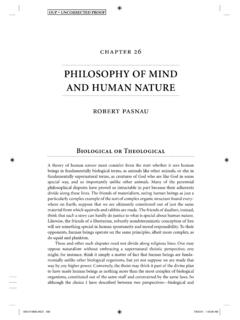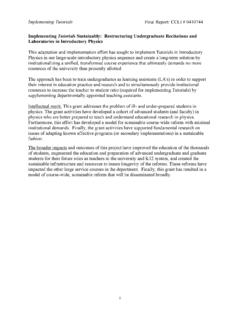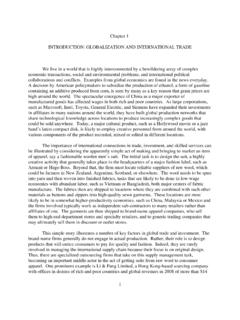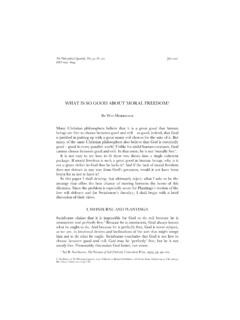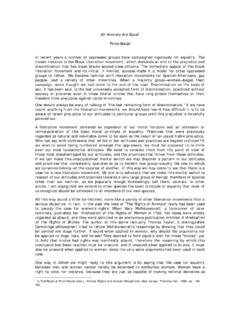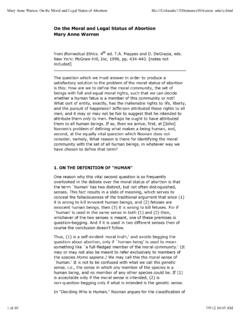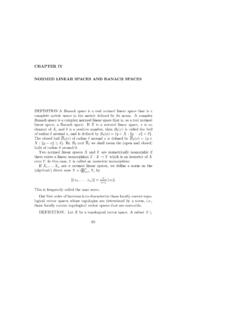Transcription of METAPHYSICS - University of Colorado Boulder
1 METAPHYSICS AN OVERVIEW Basic Concepts, Methods, Issues, Questions, and Arguments Topic I. What Is METAPHYSICS ? A Definition of METAPHYSICS : METAPHYSICS is the philosophical investigation of the ultimate nature of reality. Some Basic Types of Questions in METAPHYSICS : (1) Questions concerning reality as a whole; (2) Questions concerning things that must be true of absolutely everything that exists; (3) Questions concerning possibilities for existence; (4) Questions concerning fundamental aspects of contingent things; (5) Questions concerning the nature of human beings. The problem of Method in METAPHYSICS : Science, especially physics, is also concerned with arriving at knowledge of the ultimate nature of reality. How do the methods used in METAPHYSICS relate to, and differ from, the methods used in science? Is METAPHYSICS a legitimate discipline, rather than pure speculation, or armchair science?
2 Methods Used in METAPHYSICS , and Some Examples: (1) The appeal to what one can imagine where imagining some state of affairs involves forming a vivid image of that state of affairs. (2) The appeal to what one cannot imagine. (3) The appeal to what one can coherently conceive. (4) The appeal to what one cannot coherently conceive. (5) The appeal to intuitions about what is logically possible, or logically impossible, to support claims about what really is logically possible, or logically impossible. (Comment: Appeals of these five sorts occur, for example, in connection with the evaluation of proposed analyses of concepts, and in connection with attempts to formulate truth conditions.) (6) Conceptual analysis (7) The proof of propositions using logic alone. (Bertrand Russell and (a) the non-existence of set of all sets that do no belong to themselves, and (b) the non-existence of a set of all sets) (8) The proof of propositions using logic plus conceptual analysis.
3 (Analytic truths as derivable from logical truths in the narrow sense by the substitution of synonymous expressions.) (Examples: A cause cannot succeed its effect. All properties are completely determinate.) (9) The use of inference to the best causal explanation. (Examples: God; other minds) (10) The use of inference to the best non-causal explanation. (Examples: Laws of nature; causal relations) (11) The use of a system of logical probability to show that certain things are likely to be the case, or that certain things are unlikely to be the case. (12) The use of inference to the best account of the truth conditions of some statement. (The idea of a robust correspondence theory of truth) (Example: David Lewis's account of the truth conditions of statements about possibilities.) (13) The appeal to direct acquaintance.
4 (Example: The existence of emergent, sensuous properties) 2 The Status of Metaphysical Truths, and Questions of Method: Are some metaphysical propositions merely contingently true? If so what methods can be used to establish such contingent truths? Are some metaphysical propositions necessarily true? What methods are appropriate in such cases? Truthmakers and Metaphysical Propositions: Do all true statements require truthmaking states of affairs that are external to the statements? What about logically true, or analytically true statements? (Compare Lewis's postulation of possible worlds to supply truthmakers for modal statements.) Topic II. Identity and Persistence Two Important Preliminary Distinctions: (1) Qualitative identity versus numerical identity; (2) Numerical identity versus the unity relation. The Definition of Numerical Identity: (1) Numerical identity is a purely logical relation; (2) Numerical identity can be defined via introduction and elimination rules.
5 A Potentially Misleading Way of Talking: "synchronic identity" versus "diachronic identity". Identity is not a cross-temporal relation. Realist versus Reductionist Accounts of the Synchronic Unity Relation: (1) What makes it the case that two property instances that exist at the same time belong to one and the same thing? (2) Is the synchronic unity relation unique and unanalyzable, or is it analyzable? (3) Is it reducible, for example, to nomological connections between property instances? (4) Or does the synchronic unity relation have to be analyzed in terms of causal relations to property instances that exist at earlier times? Realist versus Reductionist Accounts of the Diachronic Unity Relation: (1) What makes it the case that two property instances that exist at different times belong to one and the same persisting thing?
6 (2) Is the diachronic unity relation unique and unanalyzable, or is it reducible, for example, to causal connections of an appropriate sort? (3) Causal connections as a necessary condition of the presence of the unity relation: Armstrong's annihilation/creation case. (4) Are all questions of identity settled once all causal relations are settled? (5) The issues raised by fission and fusion cases. The Diachronic Unity Relation and the Definition of Persisting Entities: (1) The diachronic unity as a relation not between temporal parts, but between property instances existing at different times; (2) Fission and fusion cases show that the diachronic unity relation cannot be both symmetric and transitive, whereas identity is; (3) Can one define a persisting entity ("identity over time") in terms of property instances that are related via a non-branching unity relation?
7 Topic III. Personal Identity Personal Identity - Realist and Reductionist Alternatives: (1) The diachronic unity relation is an irreducible relation, both in the case of persons, and in the case of inanimate objects; (2) The diachronic unity relation is an irreducible 3 relation in the case of immaterial egos, and so there would be a fact of the matter in fission cases; (3) Bodily identity is a necessary and sufficient condition of personal identity; (4) Brain identity is a necessary and sufficient condition of personal identity; (5) The unity relation is a matter of relations between occurrent psychological states; (6) The unity relation is a matter of relations between psychological states, both occurrent states and underlying powers; (7) The unity relation is a matter of relations between psychological states, both occurrent states and underlying powers, and also a matter of those states' being instantiated in the same underlying stuff, where the latter might be either the same brain, or the same immaterial substance.
8 Important Thought Experiments and Test Cases: (1) Interchanging psychological states between different brains; (2) The transference of psychological states and powers to a different immaterial substance; (3) The destruction of all psychological states, together with the continued existence of brain and body ; (4) Shoemaker s brain transplant case; (5) The case where one hemisphere is destroyed; (6) The case where one hemisphere is destroyed, and the other hemisphere is transplanted; (7) The case where both hemispheres are transplanted into different bodies; (8) Derek Parfit's fusion cases; (9) The reprogramming case; (10) Teletransportation cases, (a) with the same matter arranged the same way, (b) with the same matter arranged a different way, and (c) with completely different matter. Issues Raised by Derek Parfit: (1) Is it possible to make sense of the notion of "surviving" in a case where the resulting person is not identical with the original person?
9 (2) Must there always be a true answer to any question concerning identity in any conceivable case? (3) Is identity an important matter? (4) Is what matters an all-or-nothing matter, or a matter of degree? (5) Can one set out an account of memory, which is such that it is not an analytic truth that if A has a memory of experience E, then E is an experience that A had? (6) Can all mental states be described impersonally - that is, in a way that does not presuppose the existence of any person at all? (7) Does personal identity just consist in bodily and psychological continuity, or is it a further fact, independent of the facts about these continuities? (8) If there is a further fact, is it (a) a deep fact, and (b) an all-or-nothing fact? Topic IV. The Nature of the mind Some Important Issues: (1) What account is to be given of the very concept of a mind ?
10 (2) What type of analysis is to be given of statements about different types of mental states? (3) Are there any significant divisions between types of mental states, in the sense that a very different type of account might have to be given for some types of mental states than others? (4) What is the "mark" of the mental? That is to say, what is it that distinguishes states of affairs that are mental states from those that are not? (Consciousness and intentionality as two important answers.) 4 Four Different Accounts of the Analysis of Mental Concepts: (1) One anti-reductionist approach: a "raw feel", or "qualia", or phenomenalistic account; (2) A second anti-reductionist approach: intentionality as a defining property of mental states; (3) Analytical, or logical, behaviorism; (4) Functionalism, and the identification of mental states (primarily) on the basis of their causal roles, rather than on the basis of their intrinsic natures.
